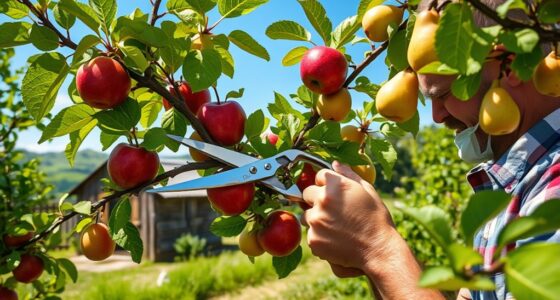To manage late blight in potatoes, you need to identify early symptoms like water-soaked lesions and fuzzy white mold. Keep an eye on weather conditions—high humidity and fluctuating temperatures make infection more likely. Improve airflow with proper spacing, rotate crops, and select resistant varieties. Use preventive fungicides and practice good hygiene to prevent the disease from spreading. Following these steps will help you protect your crop effectively; explore more strategies to stay ahead of this disease.
Key Takeaways
- Monitor plants regularly for early signs like water-soaked lesions and white mold to enable prompt action.
- Improve air circulation through proper spacing, pruning, and canopy management to reduce humidity and spore spread.
- Implement crop rotation with non-host crops and remove infected debris to break the disease cycle.
- Use resistant potato varieties and apply fungicides preventively, rotating modes of action to prevent resistance.
- Ensure proper harvesting and storage practices, including drying tubers and sanitizing equipment, to prevent post-harvest disease spread.
Recognizing the Signs of Late Blight

Recognizing the signs of late blight early can make a significant difference in controlling its spread. Look for dark, water-soaked lesions on leaves, often appearing as irregular patches with fuzzy white mold on the underside. These symptoms can quickly spread, especially in humid conditions. Implementing crop diversity helps reduce the risk, as planting resistant varieties with strong disease resistance can slow disease development. Early detection allows you to act swiftly, removing infected plants and applying appropriate fungicides. Keep a close eye on your crop, especially during wet, cool weather, when late blight thrives. Utilizing effective air filtration methods in storage areas can also help prevent the spread of spores. By understanding these early signs and choosing diverse, resistant crops, you set a foundation for better management and healthier potato yields.
Understanding the Conditions That Promote Infection
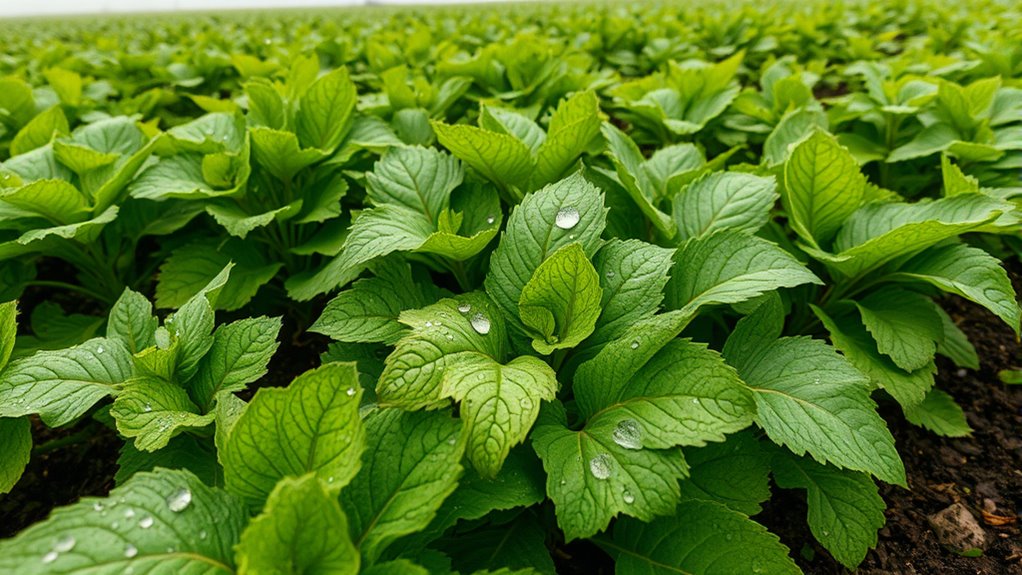
You need to be aware that high humidity and moisture create ideal conditions for late blight to develop. Fluctuating temperatures can weaken plant defenses, making infection more likely. Poor air circulation traps humidity and fosters the spread of spores, increasing your risk of outbreak. Implementing effective air filtration systems can help reduce airborne spores and limit disease spread. Maintaining proper plant spacing can also improve airflow and reduce humidity around the plants, further decreasing the risk of infection. Regularly monitoring environmental conditions can help you anticipate and prevent outbreaks before they occur. Incorporating disease-resistant potato varieties into your crop selection can significantly reduce the likelihood of infection and minimize crop losses.
Humidity and Moisture
Humidity and moisture play an essential role in the development and spread of late blight in potatoes. High humidity creates an ideal environment for the pathogen to thrive, especially when combined with wet conditions. Soil moisture is fundamental; overly saturated soil increases the risk by promoting fungal growth. To reduce this risk, you need effective irrigation management—watering early in the day allows surfaces to dry quickly, preventing prolonged leaf wetness. Avoid overwatering, as excess moisture encourages infection. Use well-draining soil and monitor moisture levels regularly. Maintaining proper soil moisture not only prevents the spread of late blight but also supports healthy potato growth. Proper moisture control helps minimize disease development and ensures optimal plant health. Incorporating aeration techniques can help reduce humidity around the plants and further lower infection risk. Additionally, ensuring good air circulation around your crop can significantly reduce leaf wetness and disease susceptibility.
Temperature Fluctuations Impact
Temperature fluctuations considerably influence the development and spread of late blight in potatoes. Sudden changes in temperature create stress on the plant, weakening its defenses and making it more vulnerable to infection. During periods of temperature stress, the pathogen can infect more easily and spread rapidly. Heat waves, in particular, exacerbate this problem by causing extreme temperature swings between hot days and cooler nights. These fluctuations can promote the pathogen’s growth cycle, increasing the likelihood of outbreaks. When temperatures fluctuate sharply, your plants become less resilient, enabling late blight spores to thrive and infect tissues more effectively. Monitoring weather patterns and recognizing periods of temperature instability are vital steps in managing late blight and minimizing its impact on your crop. Additionally, automation technologies can assist farmers in tracking weather conditions more precisely, allowing for timely interventions to protect their crops. Recognizing environmental stressors that influence disease development can further enhance management strategies, helping to mitigate the effects of temperature variability. Understanding the climate factors that affect pathogen activity can provide additional insights for effective disease control. For example, incorporating climate control strategies such as heat management can help stabilize environmental conditions and reduce stress on the plants, thereby lowering infection risk. Implementing preventive measures based on weather forecasts can help reduce infection risks before they occur.
Poor Air Circulation
Poor air circulation creates an environment that fosters late blight infection by allowing moisture to linger on potato foliage and tubers. When airflow is restricted, humidity levels stay high, giving the pathogen the perfect conditions to thrive. To combat this, focus on airflow optimization through proper planting spacing. Here are three critical steps:
- Increase planting spacing to ensure air can circulate freely between plants.
- Prune excess foliage to improve airflow around and within the canopy.
- Avoid overcrowding during planting to prevent moisture buildup and promote quick drying after rain or dew.
- Implementing ventilation techniques can further reduce humidity and improve overall airflow around the plants. Additionally, selecting proper plant varieties known for better airflow can contribute to healthier growth conditions. Regularly monitoring environmental conditions such as humidity and temperature can also help in early detection and prevention of late blight development. Maintaining good crop rotation practices can reduce the buildup of pathogens in the soil, further decreasing infection risk and highlighting the importance of integrated disease management strategies to protect crops effectively.
Selecting Resistant Potato Varieties
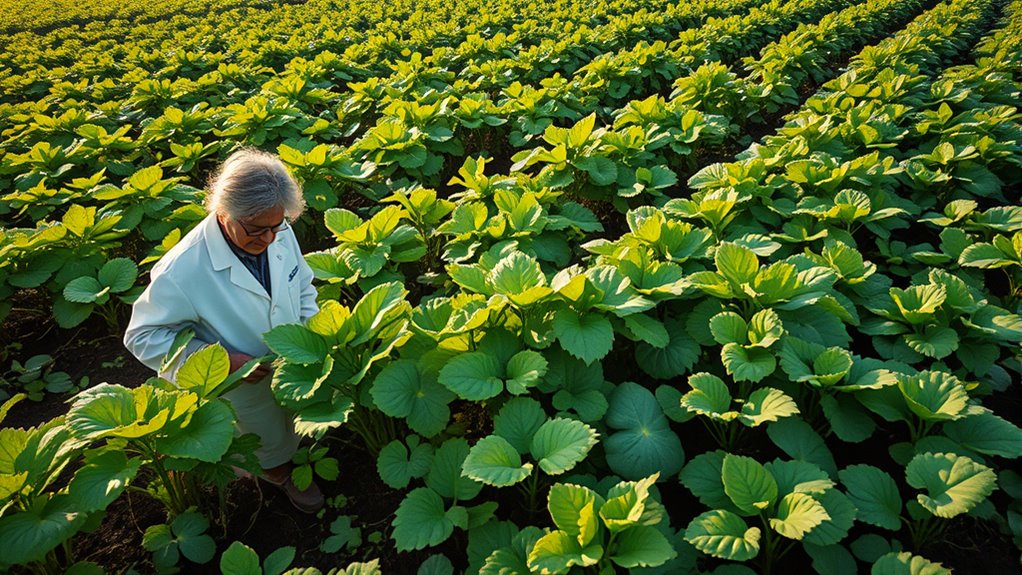
Choosing resistant potato varieties is a crucial step in managing late blight effectively. These resistant varieties can greatly reduce disease risk and lessen your reliance on chemical controls. Many breeding programs focus on developing potatoes with durable resistance, making it easier for you to protect your crop. Additionally, selecting regional-adapted varieties ensures better performance under local conditions. Understanding ethical hacking techniques can help identify vulnerabilities in your crop management systems and improve overall farm security. Here’s a quick overview:
| Resistant Varieties | Benefits |
|---|---|
| Late Blight Resistant | Lower fungicide use |
| Durable Resistance | Long-term disease control |
| Local Adapted | Better performance in your area |
Implementing natural pest management techniques can further enhance your crop’s health and resilience.
Implementing Effective Crop Rotation Practices
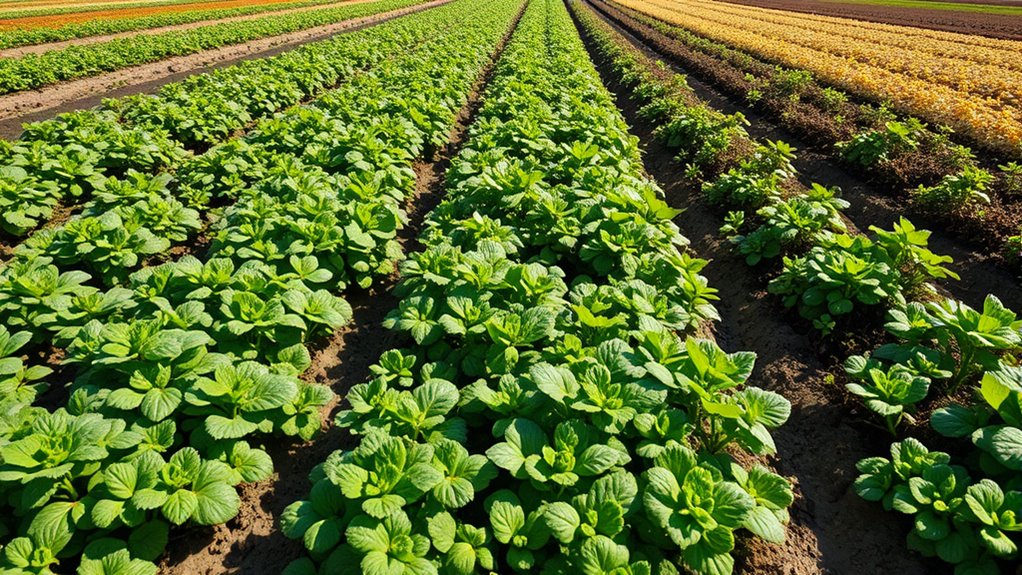
To reduce late blight risk, you should practice diverse crop selection by rotating potatoes with non-host crops. Timing your rotations correctly, ideally every one to two years, helps break the disease cycle. Consistently applying these practices will strengthen your crop’s resilience against late blight.
Diverse Crop Selection
Implementing effective crop rotation practices is essential for managing late blight in potatoes, as it helps break the disease’s life cycle and reduces pathogen buildup in the soil. To succeed, focus on diverse crop selection, which encourages crop diversification and aligns with market demand. By planting different crops, you not only disrupt the pathogen’s cycle but also increase resilience against pests and diseases. Consider these key strategies:
- Choose non-host crops like cereals or legumes to reduce late blight risk.
- Select crops with strong market demand to maximize profit and justify rotation efforts.
- Incorporate cover crops that improve soil health and suppress pathogens.
This approach keeps your farm adaptable, sustainable, and better protected against late blight outbreaks.
Timing of Rotation
Timing is crucial when rotating crops to effectively manage late blight in potatoes. You should plan rotations so that susceptible crops like potatoes are not planted consecutively, giving soil time to break the disease cycle. Incorporating crop diversification helps reduce pathogen buildup and disrupts late blight spread. Rotating with non-host plants improves soil health, making it more resilient against diseases. Proper timing ensures that you don’t plant potatoes too soon after a previous crop, which could leave residual spores in the soil. By staggering planting schedules and selecting diverse crops, you enhance soil vitality and lower disease risk. Consistent, well-timed rotations are key to managing late blight, protecting your harvest, and maintaining a healthy, productive farm.
Applying Fungicides Strategically

Strategic application of fungicides is essential for effectively managing late blight in potatoes. Proper fungicide application timing ensures you target the disease early, preventing outbreaks that can devastate your crop. To maximize effectiveness and avoid fungicide resistance management issues, don’t rely on a single product; rotate fungicides with different modes of action. Here are key steps to keep in mind:
- Monitor weather and disease signs closely—timing is everything.
- Apply fungicides preventively and at the first sign of blight—early intervention saves your crop.
- Use tank mixes and rotate fungicides regularly—this reduces resistance buildup and prolongs product efficacy.
Managing Field Hygiene and Sanitation
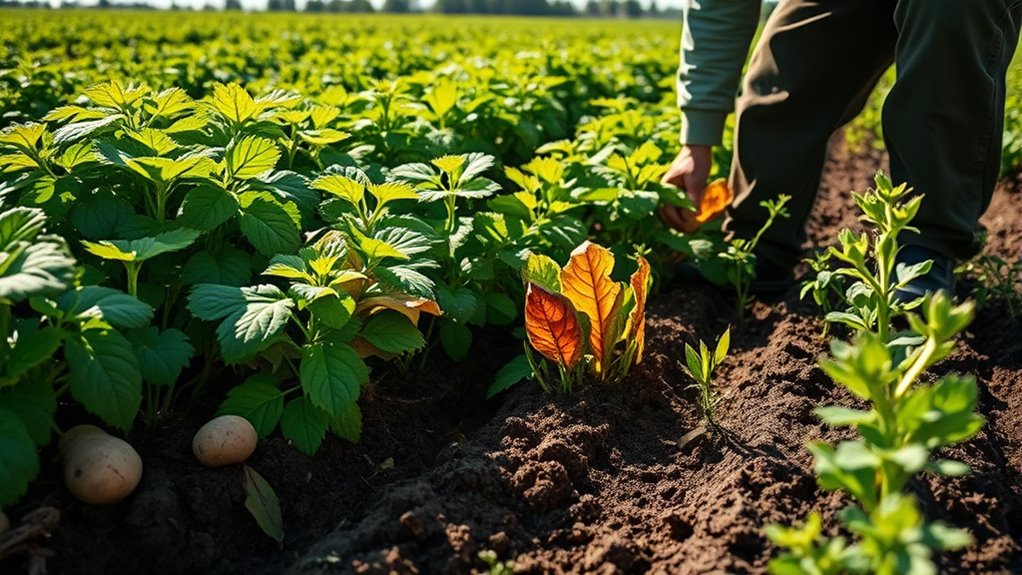
Maintaining clean field conditions plays a vital role in controlling late blight in potatoes. Start by ensuring proper sanitation of all equipment, including tools and machinery, to prevent disease spread. Regularly disinfect equipment after use, especially if it has come into contact with infected plants. Incorporate soil amendments that improve drainage and reduce humidity, creating less favorable conditions for the pathogen. Remove and destroy infected plant debris and volunteer plants promptly, as they serve as sources of inoculum. Keep the field free of weeds that can harbor late blight spores. Practice crop rotation to minimize pathogen buildup in the soil. By prioritizing equipment sanitation, managing soil health with amendments, and maintaining a clean environment, you greatly reduce the risk of disease development and protect your potato crop.
Monitoring and Forecasting Disease Development

Monitoring and forecasting late blight development are essential for effective disease management. By staying vigilant, you can catch early signs and act promptly. Using tools like disease prediction models helps you anticipate outbreaks, giving you a critical edge. Focus on three key actions:
Stay vigilant with weather tracking, early symptom observation, and resistant varieties to combat late blight effectively.
- Track weather patterns—wet, humid conditions heighten risk.
- Observe plant health closely—spot early symptoms like water-soaked spots.
- Implement irrigation management—avoid overwatering to reduce leaf moisture that fosters the disease.
Additionally, selecting potato varieties with genetic resistance can markedly lower your vulnerability. Combining vigilant monitoring with smart irrigation and resistant cultivars maximizes your control over late blight, reducing crop losses and ensuring a healthier harvest. Staying proactive keeps you ahead of the disease curve.
Post-Harvest Handling to Prevent Spread
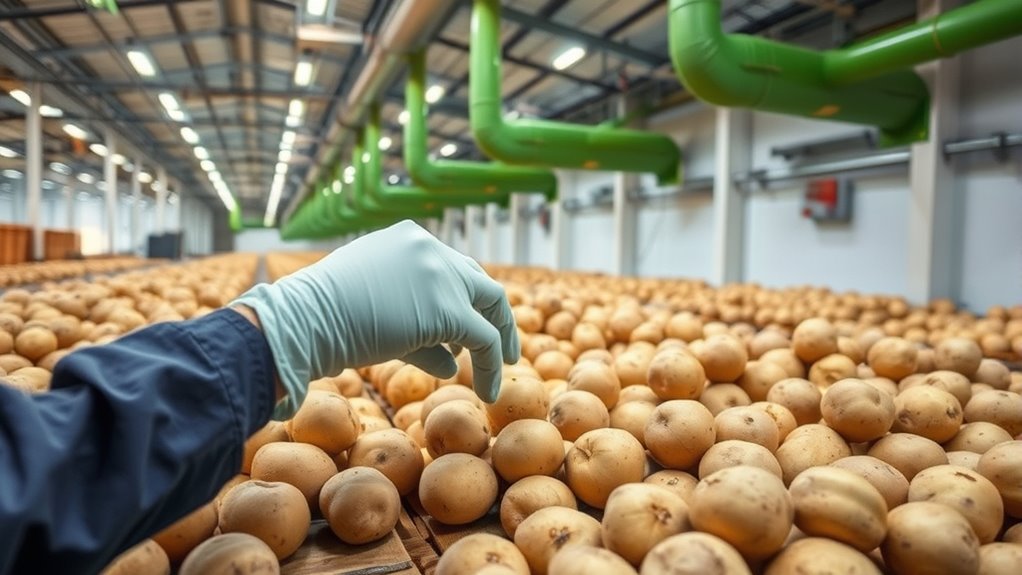
After harvesting your potatoes, proper handling is essential to prevent the spread of late blight and other diseases. Make sure you dry the tubers thoroughly before storage to reduce moisture that fosters disease development. During post-harvest storage, keep temperatures cool and maintain good airflow to inhibit pathogen growth. Container sanitation is critical; thoroughly clean and disinfect all storage bins and crates before use. Avoid crowding potatoes in containers, as tight packing can promote rot and disease spread. Regularly inspect stored potatoes for signs of disease and remove any affected tubers immediately. Proper post-harvest handling minimizes the risk of late blight spreading to healthy potatoes, protecting your harvest and ensuring quality throughout storage.
Frequently Asked Questions
What Are the Economic Impacts of Late Blight on Potato Farmers?
You face significant economic losses when late blight strikes your potato crop, as it reduces yield and quality. These losses can lead to decreased income and increased production costs. Market disruptions may follow, with lower supply affecting prices and demand. Overall, late blight causes financial strain on farmers like you, impacting your profitability and the stability of local and global potato markets.
How Can Organic Methods Help Control Late Blight?
Imagine fighting a relentless enemy without synthetic chemicals—organic methods offer natural defenses. You can use organic barriers like copper sprays and compost mulches to block pathogen entry. Botanical solutions, such as neem oil and garlic extracts, act as natural fungicides. While not foolproof, these approaches reduce late blight risk, promote sustainable farming, and protect your crop without harming the environment. Organic methods empower you to manage late blight naturally.
Are There Biological Control Options for Managing Late Blight?
You can explore biological controls for managing late blight by using natural antagonists like certain beneficial microbes. These biological controls work by suppressing the pathogen, reducing the spread of the disease. You might consider applying specific biocontrol agents that target late blight directly, offering an eco-friendly alternative to chemical treatments. Incorporating biological controls into your management plan helps protect your crops while promoting sustainable farming practices.
How Does Climate Change Influence Late Blight Outbreaks?
Climate change is a game changer, making it harder to stay ahead. Rising climate variability creates unpredictable conditions that favor late blight outbreaks, while warmer temperatures and increased humidity boost pathogen adaptation. You’ll find that these shifts lead to more frequent and severe outbreaks, forcing you to adapt your management strategies. Staying vigilant and flexible is key, as nature’s unpredictable changes can turn the tides in your fight against this persistent threat.
What Are the Best Practices for Educating Farmers About Late Blight Prevention?
You should prioritize farmer training and awareness campaigns to improve late blight prevention. Use clear, practical information on identifying symptoms and applying proper fungicide treatments. Organize workshops and distribute educational materials to guarantee farmers understand risk factors and best practices. Engaging local communities and leveraging media can boost awareness, empowering farmers to take early action and reduce crop losses effectively.
Conclusion
By staying vigilant and applying these strategies, you can effectively manage late blight in your potatoes. Remember to recognize early signs, choose resistant varieties, and maintain good field hygiene. Will you take the necessary steps today to protect your crop and ensure a healthy harvest tomorrow? With proactive management, you can stay ahead of the disease and secure your potato yield for the future. The choice is yours—are you ready to act?



